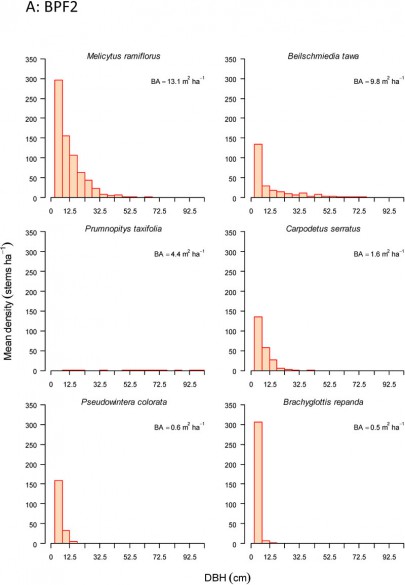Melicytus ramiflorus - Cyathea smithii - Dicksonia squarrosa - Carpodetus serratus (Beilschmiedia tawa) forest
In this section
Common name: Mahoe forest
Code: A: BPF2
Where does it occur?
This 393 000 ha alliance occurs between 37 and 43°S on both North and South islands, from 80–820 m altitude.
Description
The forest is dominated by Melicytus ramiflorus, Carpodetus serratus and the tree ferns Cyathea smithii and Dicksonia squarrosa. Other canopy species that may be important are Beilschmiedia tawa, Weinmannia racemosa, Hedycarya arborea, Schefflera digitata and Knightia excelsa.

A: BPF2. Size structure of canopy dominants.
Important species in the subcanopy are Coprosma grandifolia, Clematis paniculata, Geniostoma rupestre, Brachyglottis repanda and the tree fern Cyathea dealbata. Important species on the ground layer are Uncinia uncinata, Microsorum pustulatum, Asplenium bulbiferum, Blechnum chambersii, B. fluviatile, Microlaena avenacea, Leptopteris hymenophylloides and Pyrrosia eleagnifolia. Climbing rata (Metrosideros diffusa) and Ripogonum scandens are common epiphytes. Species richness is moderate with on average 47 species per plot (Table 4), with nearly half of these being measurable trees. Ferns are important in this forest class, comprising on average 33% of the species, the most common species being Asplenium flaccidum, Microsorum pustulatum and Blechnum chambersii. Exotic species richness is typically low (mean = 2 per plot, range 0–14) but no individual species is particularly frequent.
Indicator species
Co-occurrence of Melicytus ramiflorus, Cyathea smithii, Dicksonia squarrosa and Blechnum fluviatile
Stand characteristics
| Mean canopy height (m): | 18 m (range 5–45) |
| Mean stem density (stems/ha): | 3679 (317) |
| Mean basal area (m2/ha): | 63 (3.3) |
Synonyms
| Relationship | Name | Author |
|---|---|---|
| is included within | Broadleaved scrub/forest | Singers & Rogers (unpublished) |
| overlaps with | Kamahi broadleaved podocarp forest | Singers & Rogers (unpublished) |
| overlaps with | Temperate bush: Bush of steep, unstable slopes | Wardle (1991) |
Component Associations
Melicytus ramiflorus – Weinmannia racemosa – Carpodetus serratus /Cyathea smithi – Coprosma grandifolia / Microlaena avenacea forest
Common name: Māhoe – kāmahi – marbleleaf forest
Code: a: BL6
Where does it occur?
This 68 000 ha association has been sampled on the South Island only, primarily in the region between the upper Rakaia and upper Rangitata Rivers. Sites range from flat to steeply sloping (50º). Altitudes range from 70 to 850 m.
Description
This forest association is, on average, 13 m tall but can range widely from 5 to 45 m. It tends to be species-rich with an average of 43 species on a plot which can range from 19 to 59. On average, there are few (less than 2%) exotic species present.
Melicytus ramiflorus – Hedycarya arborea – Beilschmiedia tawa / Schefflera digita / Ripogonum scandens – Asplenium bulbiferum forest
Common name: Māhoe – pigeonwood – tawa forest
Code: a: BL4
Where does it occur?
This 98 300 ha association has been sampled from scattered sites throughout the North Island. Sites range from flat to very steeply sloping (70º). Altitudes range from 116 to 685 m.
Description
This forest association is, on average, 17 m tall but can range widely from 4 to 65 m. It tends to be species-rich with an average of 46 species on a plot which can range from 32 to 67. On average, there are few (less than 2%) exotic species present.
References
Wiser, S.K., Hurst, J.M. 2010. Composition and structure of 24 New Zealand forest and shrubland vegetation communities. Landcare Research Contract Report LC0910-073. Prepared for the Department of Conservation and the Sustainable Management Fund of the Ministry of Agriculture and Forestry.
Wiser, S.K., J.M. Hurst, R.B. Allen, E.F. Wright. 2011. New Zealand’s forest and shrubland communities: a classification based on a nationally representative plot network. Applied Vegetation Science 14: 506-523.
Wiser, S.K.; De Cáceres, M. 2013. Updating vegetation classifications: an example with New Zealand's woody vegetation. Journal of Vegetation Science 24: 80-93.
De Cáceres M, Legendre P, Wiser SK, Brotons L (2012) Using species combinations in indicator value analyses. Methods in Ecology and Evolution 3(6): 973-982.



